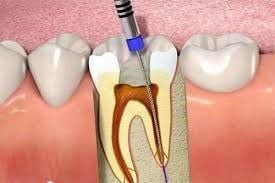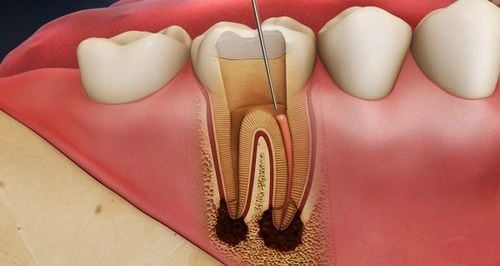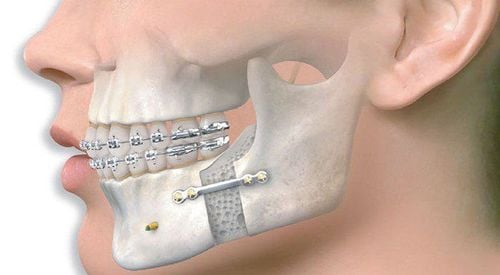This is an automatically translated article.
Root canal therapy (endodontics) is a medical procedure that treats inflammation in the central part of a tooth. This form of treatment will not cause too much pain and can help patients keep their teeth without having to replace them with dentures.
1.Why is root canal treatment so necessary?
Inflammation in the pulp (inside the dentin) is usually caused by the attack of bacteria that exist in the oral cavity.
This usually occurs when:
The patient's teeth are decayed The filling is cracked and leaking Teeth are damaged by falls and other causes To understand the need for root canal treatment, first, we need to understand the structure of the tooth and why we need to treat the pulp
a. Structure of teeth Teeth are made up of two main parts: crown (shown outside the oral cavity), which is the main impact place for chewing and biting; roots (located inside the gums), which help fix the teeth to the jawbone.
Teeth also include other components such as:
Enamel - a hard shell that covers the outside of the tooth dentin - a softer layer than enamel and is responsible for strengthening tooth enamel and shaping teeth Bone - a layer hard cells that help cover the root of the tooth Pulp layer - the layer of nerve tissue and blood vessels located at the center of the tooth The root canal system of a tooth is the space containing the tooth pulp that runs from the inner part of the crown to the root tooth. A single tooth can contain multiple root canal systems.

Hình ảnh tủy răng bị hoại tử cần được điều trị
The pulp (in the crown) will begin to necrosis if the intensity of the bacterial attack does not decrease and spreads.
Symptoms that appear when the pulp is infected include:
Pain when using hot and cold foods and drinks Pain when biting and chewing in the area of the tooth affected by the infection Back tooth lay When the inflammation in the tooth (cavity) progresses, the above symptoms will stop appearing, signaling that this pulp area has completely died.
After that, the patient will feel like the tooth has healed on its own, but in fact, the inflammatory process has spread to the end of the pulp system at the root of the tooth.
Next will be the appearance of symptoms such as:
The pain of toothache when biting or chewing returns The gum area near the decayed tooth becomes swollen Tooth decay leaking pus Swollen face Teeth become dark color It becomes very urgent to see a doctor if the patient's teeth begin to show signs of pain. If the tooth becomes infected, the pulp will not be able to heal on its own.
If tooth decay is not treated or removed, the situation will get worse. This will reduce the success rate of this form of root canal treatment as the infection spreads to other teeth.
Antibiotics will not be effective in treating tooth pulp.
2.How to conduct root canal treatment
For this form of treatment to be effective, the bacteria in the tooth need to be removed in one of two ways:
Eliminate bacteria in the pulp system (root canal treatment) Completely remove the caries Method of extraction Removal of decayed teeth is not often recommended by doctors because it is very good for the patient to keep the natural teeth.
After the bacteria in the tooth is cleaned, the tooth will be filled in and the doctor will conduct a filling or crown.
In the vast majority of cases, the gum swelling around the decayed tooth will heal on its own.
Before conducting this form of root canal treatment, the doctor usually gives the patient a local anesthetic. This means the treatment won't be too painful or uncomfortable.
This is a form of root canal treatment with a success rate as high as 90 percent. Teeth can maintain stable function for more than 10 years after being treated with this form.
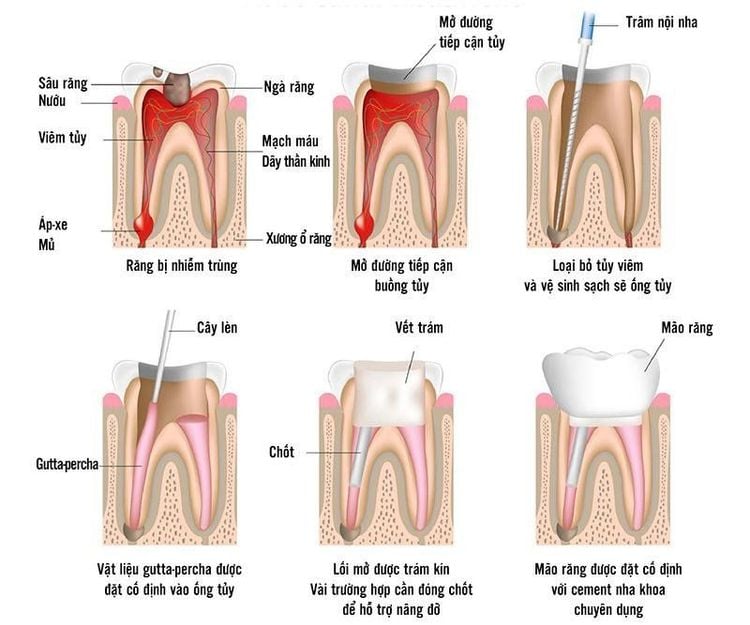
Quy trình điều trị tủy răng
3. This course of treatment will usually be divided into two or more sessions
Patients will have to pay for this form of treatment on their own if not enrolled in dental insurance.
a. Preparation Before commencing root canal treatment, your dentist may take x-rays of the infected tooth to get a thorough look at the tooth's pulp system and thereby assess the extent of the damage.
This form of treatment is often accompanied by local anesthesia for the patient to minimize pain during the procedure, especially in the decayed (inflamed) tooth and surrounding gums.
In some cases when the patient has lost sensation in the carious tooth, local anesthesia is not necessary.
b. Removal of the necrotic pulp area The doctor will place an absorbent gauze around the decayed tooth to ensure dryness during the treatment.
Cotton swabs also help prevent patients from swallowing chemicals that doctors use during treatment.
The doctor will start by drilling an opening into the pulp in the center of the tooth and then using specialized tools to remove all the necrotic pulp.
The doctor can also aspirate the pus in the abscess if this swelling is present.
c. Cleaning and filling the root canal After the dead pulp has been removed, the doctor will clean and re-fill the canal
Root canals are often very narrow and difficult to fill. Therefore, the doctor will use small files to widen the canals and bring them back to their normal shape so that the obturator can be filled.
This process often takes hours and needs to be broken up in batches.
Incisors and canines usually contain only one canal in one root. Meanwhile, premolars and molars usually have 2 to 3 roots and each root contains 1 or 2 canals.
The more roots a tooth has, the more time it takes to perform
If the root canal treatment needs to be done in several sessions, the doctor may put a small amount of medicine into the cleaned part of the canal to remove probably the amount of bacteria.
Then the tooth will be covered with a temporary filling.
If the patient develops symptoms due to an inflammatory condition such as fever or swollen gums, the doctor may suggest antibiotics.
d. Filling and repair of teeth At the patient's next visit, the doctor will remove the temporary filling and medicine to proceed with the use of a permanent filling to fill the root canal. This will help seal the root canal and prevent re-infection.
Teeth with filled roots are often more susceptible to damage than unaffected natural teeth. Therefore, the doctor may recommend to the patient the placement of crowns to protect them.
In some cases, the tooth with the root to be filled will become dark due to the dead pulp or due to strong impact.
There are several ways to help remove the original discoloration of teeth, such as chemical whitening.
e. Placing a crown for a tooth A crown is a layer that covers the crown of the tooth, helping to protect the tooth that has undergone root canal treatment from cracking.
The composition of the types of crowns for teeth are usually:
Metal or porcelain (sometimes both) Ceramic material Glass powder The doctor will grind down the tooth size to make the crown. The crown will be estimated by molding to ensure the correct size when placed on the tooth. An adhesive will be used to strengthen the tooth and crown. If the tooth has been heavily chipped after root canal treatment, a screw will be fixed to the root with an adhesive to hold the crown in place.
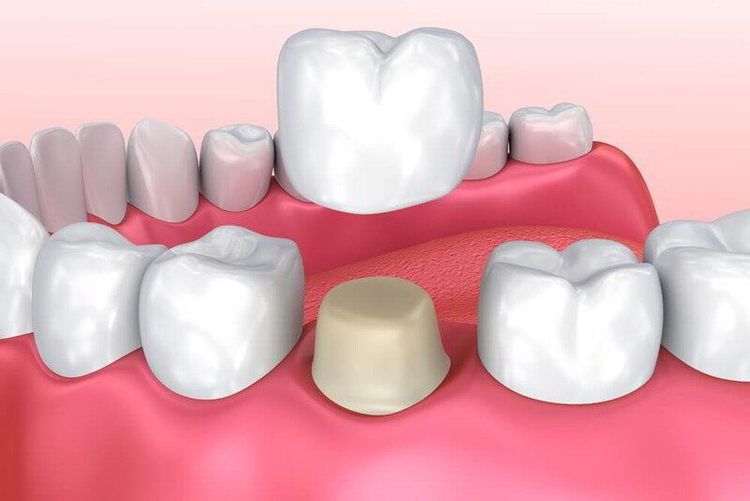
Đặt mão cho răng bằng sứ giúp bảo vệ răng sau khi đã điều trị tủy răng
4.Success of root canal treatment
Root canal treatments often have a high success rate in keeping the natural tooth and completely clearing the infection. About 9 out of 10 teeth that undergo this treatment are likely to remain stable for 8 to 10 years. For teeth that are crowned after undergoing root canal treatment, their ability to maintain stability will be increased.
Teeth will become even stronger if patients practice proper oral hygiene. In addition, the life expectancy of the tooth after undergoing root canal treatment also depends on a number of factors such as:
The natural tooth remaining after the treatment (teeth will usually be chiseled to perform the process). therapy) Patient's oral hygiene Intensity of use of the patient's teeth Root canal treatments can still be repeated if the infection continues to recur. In case the tooth is still infected after undergoing treatment, the doctor may recommend a minor form of treatment called root canalectomy to put an end to the condition.
5.Recovery after root canal treatment
It is very important to take care of your teeth after undergoing treatment. Patients should avoid the use of hard foods until the treatment is complete. The tooth, after root canal treatment, should no longer cause pain, although it may feel lumpy for a few days.
Pain relievers or anti-inflammatory drugs such as paracetamol and ibuprofen can be used to reduce post-treatment discomfort.
Patients can return to the dental clinic for a check-up if they still feel pain and swelling after taking the pain medication.
Prevent future dental infections by:
Proper oral hygiene Do not eat too many sugary foods Give up smoking habits Currently, Vinmec International General Hospital is applying Using the technique of root canal treatment and sealing of the root canal system with cold Gutta percha using a rotating file, root canal treatment is a technique that has existed for a long time, but treatment with a machine file has only been around for a few years. , and Vinmec always approaches new technologies to aim for the best oral health care for everyone.
When choosing root canal treatment at Vinmec International General Hospital, patients will be examined and treated by a team of experienced and highly specialized doctors, with the support of a system of specialized machines. Modern department, absolutely sterile.
Please dial HOTLINE for more information or register for an appointment HERE. Download MyVinmec app to make appointments faster and to manage your bookings easily.
Reference source: nhs.uk



